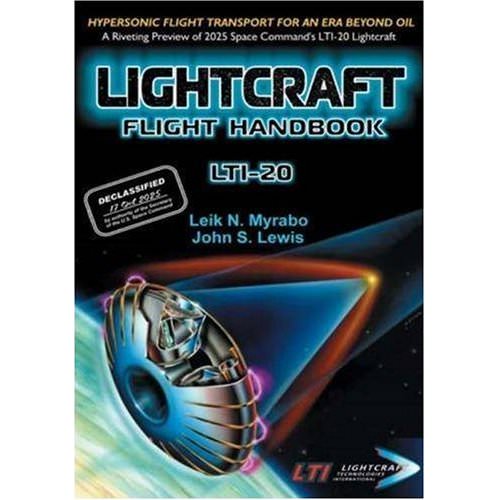[/caption]
The major shortcoming of current chemical powered rockets lies in the ratio of payload to fuel. The dream of rocketeers would have a spacecraft almost all payload. Leik Myrabo and John Lewis have an idea for this and they present it in the book “Lightcraft – Flight Handbook LTI-20 “. Within the book lies great detail on a special flying craft and some of its essential subsystems.
This book aims to extol the virtues of a large craft that relies upon microwaves to transfer energy from one location to itself. Via this, the craft need not carry any significant power supply, though the book does mention backup batteries. Further, the book describes, with great relish, the use of ionizers that create the thrust and provide the flight control. Though perhaps sounding farfetched, one author, Leik Myrabo, is recognized as being a worldwide expert in this field and he has undertaken trials on laser launched vehicles. From this, the book has an authoritative ring.
Now the book’s subject does sound very futuristic. And the book’s layout acknowledges this by being written as a flight handbook for travellers in the year 2025. That is, if you were to take a ride on the LTI-20 laser powered craft, then you would need to know the contents of the book so as to understand the craft’s functionality. Hence, the result for the reader is a book that smacks whole heartedly of science fiction even though practical research has taken place.
So here’s your dilemma regarding this book. Do you buy it for the fun science fiction or do you buy it because of the novel method of power supply and flight control. If you want both, then you are in luck. If you like science fiction technology, such as headgear for partial liquid ventilation, this book has lots, but it’s very disjointed and most topics are unsubstantiated. If you want to know more about laser power, this book has the details, but at the level of an article for Popular Mechanics. And sadly, the connection between the future described within the book and current research is tenuous at best. Hence, this book, while entertaining, lacks from a practical stand point.
Nevertheless, there is no mistaking the potential of microwaves to transfer energy to flying craft as described within. As well, ionizers should provide effective flight control, at least while a sufficient quantity of atoms exist (i.e. this won’t work in space). So, for the pleasure of reading about cutting edge technology then Leik Myrabo and John Lewis’ book “Lightcraft – Flight Handbook LTI-20 ” is for you.


A bit off the norm for Universe Today, but I do like the idea of getting away from the standard rocket shape/liquid fuel consuming spacecraft.